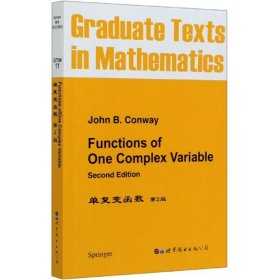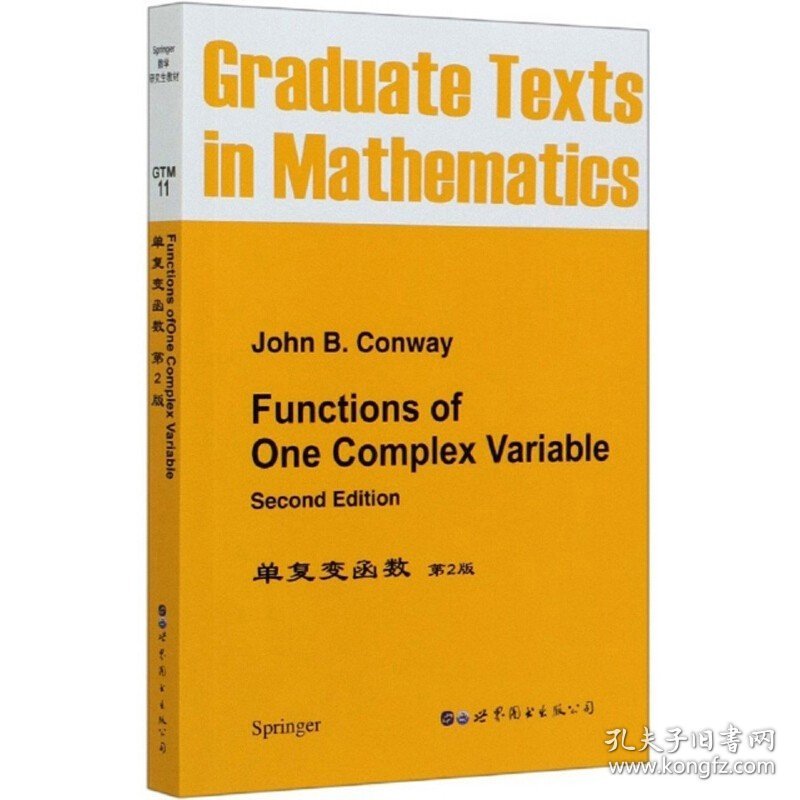
单复变函数 第2版 英文版 康威 Functions of One Complex Variable 2ed/John B.Conway世界图书出版公司 Springer数学研究生教材
9787506271912
¥ 63.9 全新
库存3件
河北廊坊
认证卖家担保交易快速发货售后保障
作者John B.Conway
出版社世界图书出版有限公司北京分公司
ISBN9787506271912
出版时间2020-01
装帧平装
货号701014172813
上书时间2024-02-21
- 最新上架
商品详情
- 品相描述:全新
- 商品描述
- 内容简介 I have been very pleased with the success of my book. When it was apparent that the second printing was nearly sold out, Springer-Verlag asked me to prepare a list of corrections for a third printing. When I mentioned that I had some ideas for more substantial revisions, they reacted with characteristic enthusiasm. There are four major differences between the present edition and its predecessor. First, John Dixon's treatment of Cauchy's Theorem has been included. This has the advantage of providing a quick proof of the theorem in its full generality. Nevertheless, I have a strong attachment to the homotopic version that appeared in the first edition and have proved this form of Cauchy's Theorem as it was done there. This version is very geometric and quite easy to apply. Moreover, the notion of homotopy is needed for the later treatment of the monodromy theorem; hence, inclusion of this version yields benefits far in excess of the time needed to discuss it. Second, the proof of Runge's Theorem is new. The present proof is due to Sandy Grabiner and does not use "pole pushing". In a sense the "pole pushing" is buried in the concept of uniform approximation and some ideas from Banach algebras. Nevertheless, it should be emphasized that the proof is entirely elementary in that it relies only on the material presented in this text. Next, an Appendix B has been added. This appendix contains some bibliographical material and a guide for further reading. Finally, several additional exercises have been added. There are also minor changes that have been made. Several colleagues in the mathematical community have helped me greatly by providing constructive criticism and pointing out typographical errors. I wish to thank publicly Earl Berkson, Louis Brickman, James Deddens, Gerard Keough, G. K. Kristiansen, Andrew Lenard, John Mairhuber, Donald C. Meyers, Jeffrey Nunemacher, Robert Olin, Donald Perlis, John Plaster, Hans Sagan, Glenn Schober, David Stegenga, Richard Varga, James P. Williams, and Max Zorn. Finally, I wish to thank the staff at Springer-Verlag New York not only for their treatment of my book, but also for the publication of so many fine books on mathematics. In the present time of shrinking graduate enrollments and the consequent reluctance of so many publishers to print advanced texts and monographs, Springer-Verlag is making a contribution to our discipline by increasing its efforts to disseminate the recent developments in mathematics. 前言/序言 I have been very pleased with the success of my book. When it was apparent that the second printing was nearly sold out, Springer-Verlag asked me to prepare a list of corrections for a third printing. When I mentioned that I had some ideas for more substantial revisions, they reacted with characteristic enthusiasm. There are four major differences between the present edition and its predecessor. First, John Dixon's treatment of Cauchy's Theorem has been included. This has the advantage of providing a quick proof of the theorem in its full generality. Nevertheless, I have a strong attachment to the homotopic version that appeared in the first edition and have proved this form of Cauchy's Theorem as it was done there. This version is very geometric and quite easy to apply. Moreover, the notion of homotopy is needed for the later treatment of the monodromy theorem; hence, inclusion of this version yields benefits far in excess of the time needed to discuss it. Second, the proof of Runge's Theorem is new. The present proof is due to Sandy Grabiner and does not use "pole pushing". In a sense the "pole pushing" is buried in the concept of uniform approximation and some ideas from Banach algebras. Nevertheless, it should be emphasized that the proof is entirely elementary in that it relies only on the material presented in this text. Next, an Appendix B has been added. This appendix contains some bibliographical material and a guide for further reading. Finally, several additional exercises have been added. There are also minor changes that have been made. Several colleagues in the mathematical community have helped me greatly by providing constructive criticism and pointing out typographical errors. I wish to thank publicly Earl Berkson, Louis Brickman, James Deddens, Gerard Keough, G. K. Kristiansen, Andrew Lenard, John Mairhuber, Donald C. Meyers, Jeffrey Nunemacher, Robert Olin, Donald Perlis, John Plaster, Hans Sagan, Glenn Schober, David Stegenga, Richard Varga, James P. Williams, and Max Zorn. Finally, I wish to thank the staff at Springer-Verlag New York not only for their treatment of my book, but also for the publication of so many fine books on mathematics. In the present time of shrinking graduate enrollments and the consequent reluctance of so many publishers to print advanced texts and monographs, Springer-Verlag is making a contribution to our discipline by increasing its efforts to disseminate the recent developments in mathematics. '
— 没有更多了 —












以下为对购买帮助不大的评价